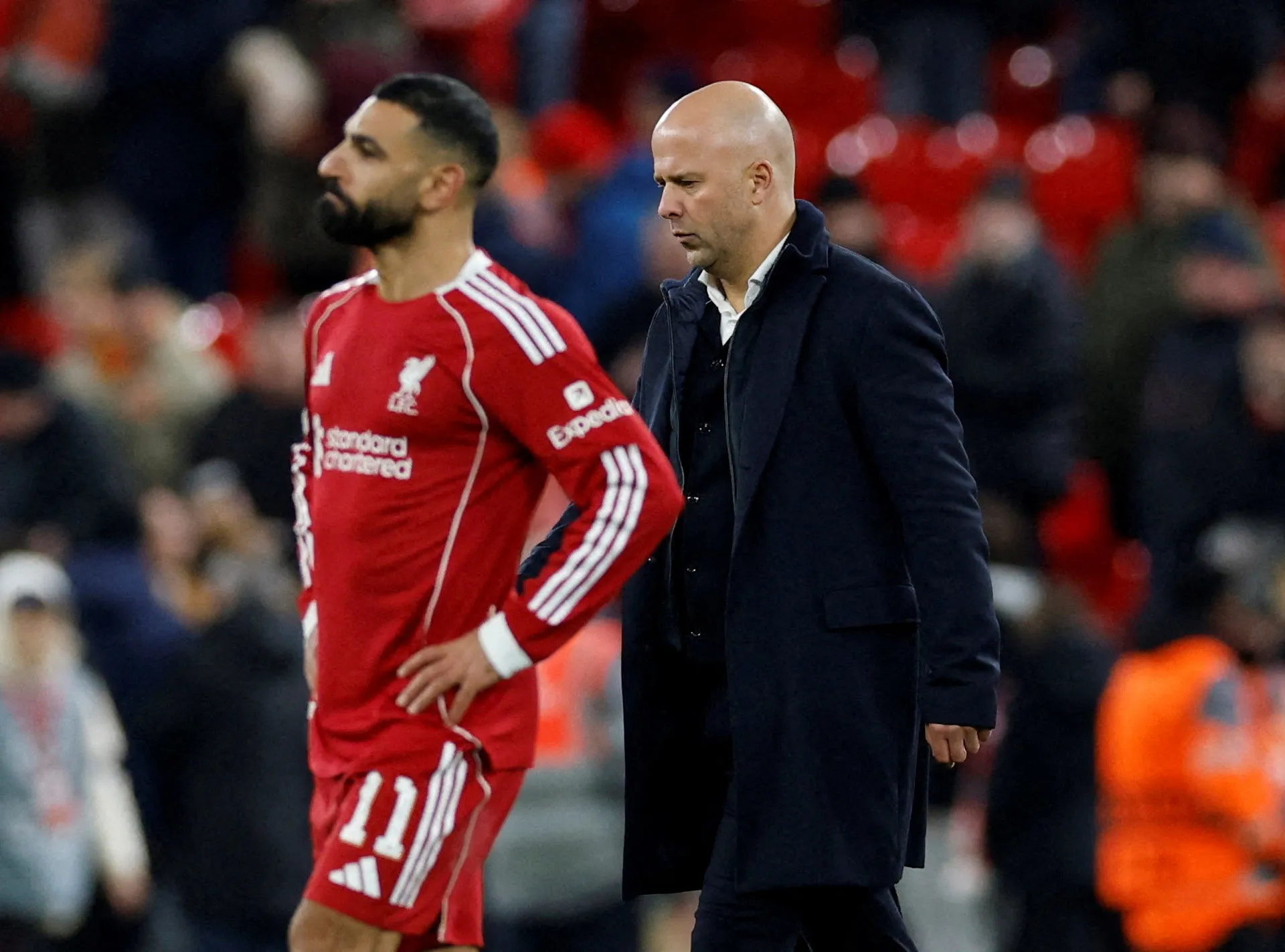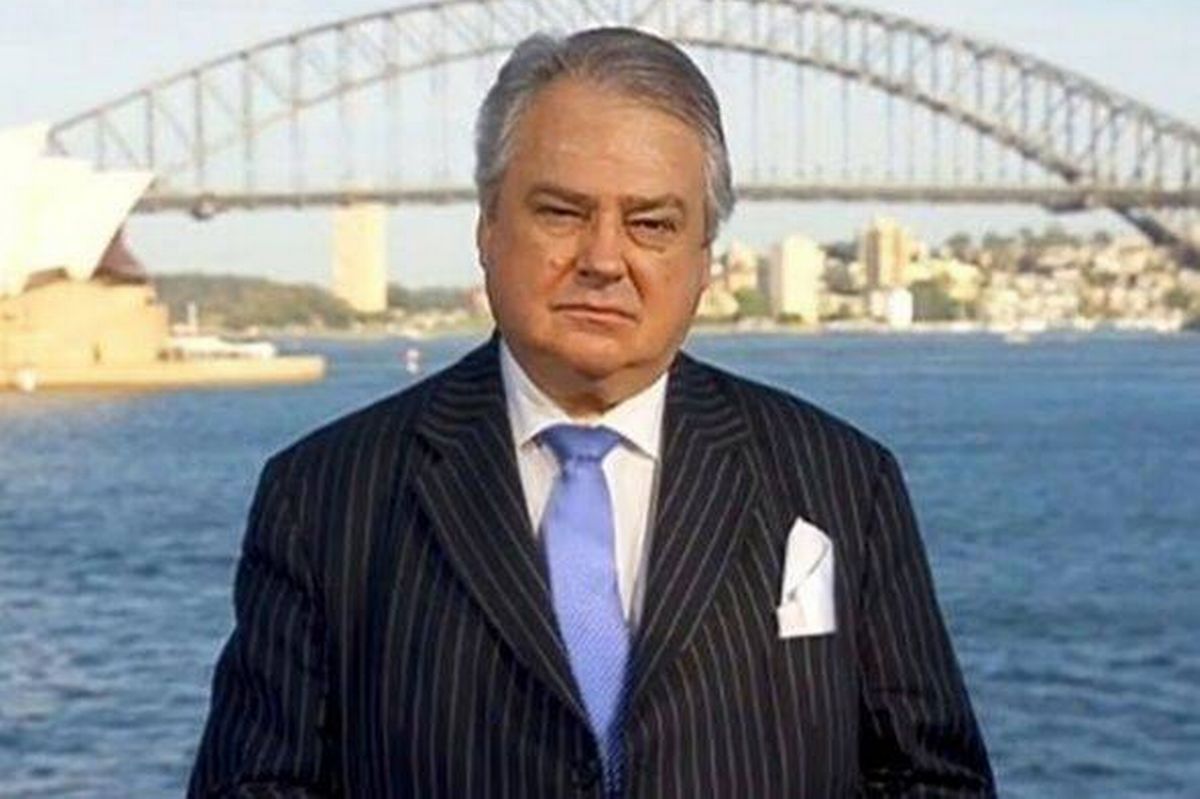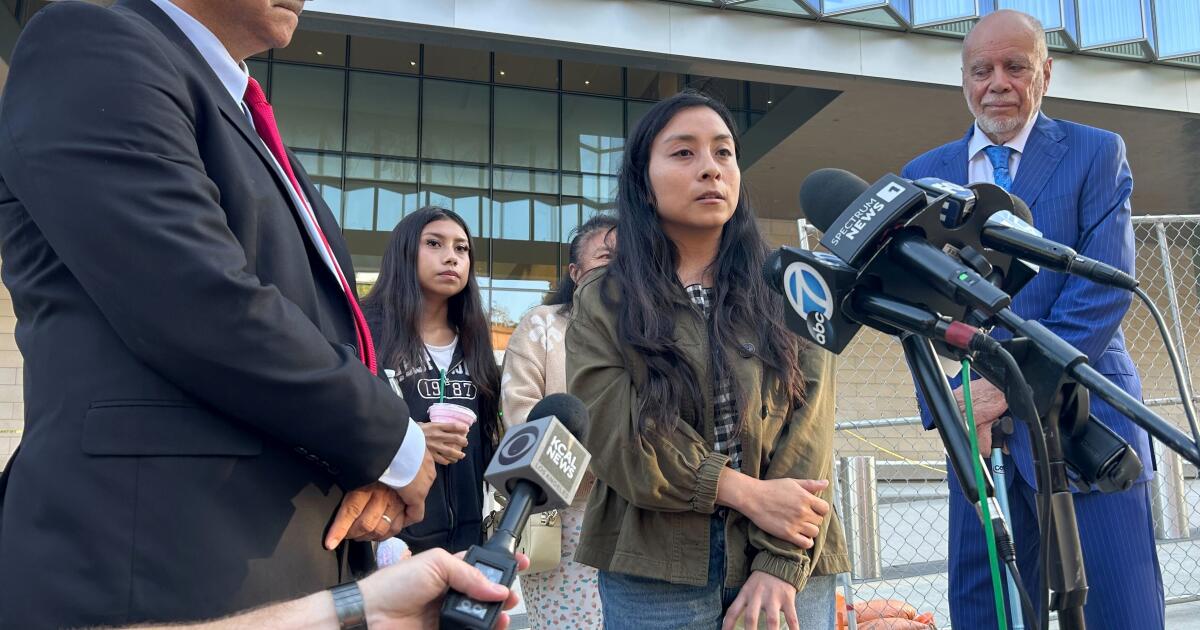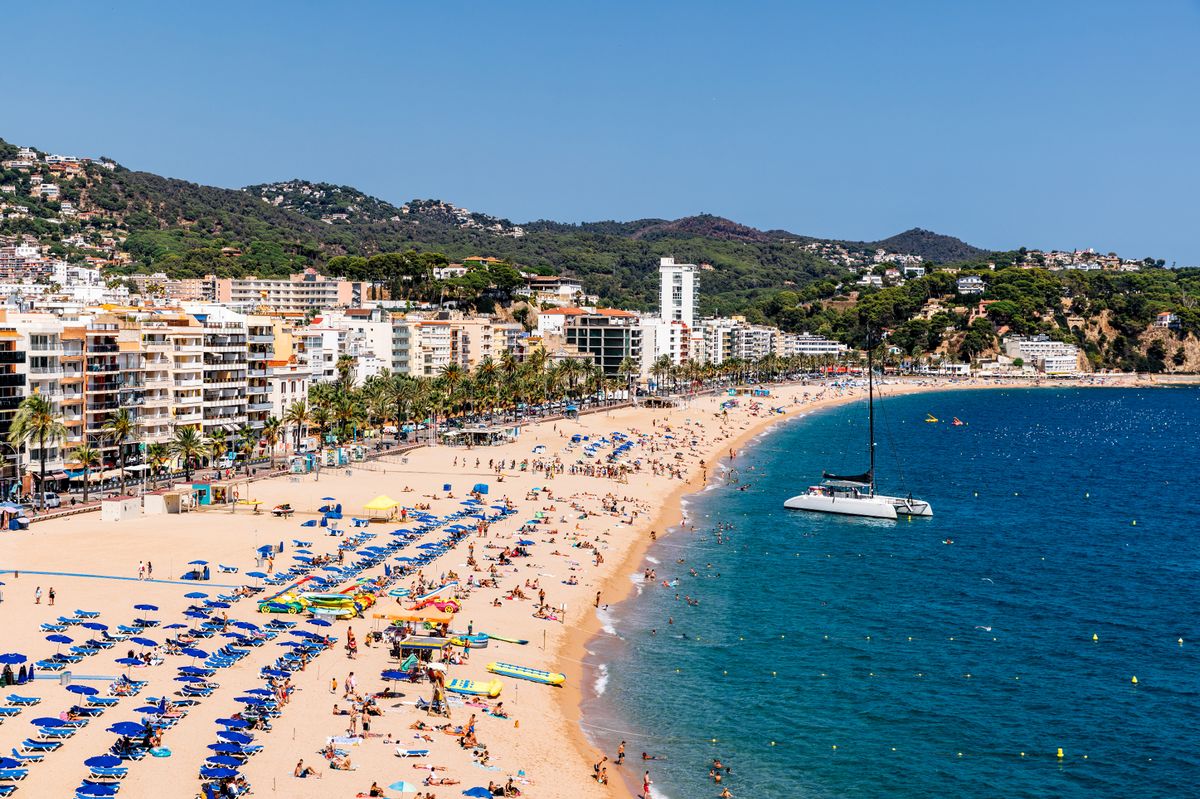Formula 1: New Concorde Agreement signed between F1, FIA and teams
The document is named after the Place de la Concorde in Paris, where the first such agreement was finalised in 1981 after a period of conflict between the FIA and the teams, then led by Bernie Ecclestone, external.
The new deal has taken most of this year to finalise, after the teams reached their own commercial agreements with F1 in March.
FIA president Mohammed Ben Sulayem, who was appointed to a new four-year term on Friday following an election in which he was unopposed, has been consistent in the past four years in trying to secure more money for the FIA from F1.
The FIA depends to a large part on F1 for its income and paid in the region of $40m (£30m) annually in the last Concorde Agreement.
F1 president and chief executive officer Stefano Domenicali said: “This agreement ensures F1 is in the best possible position to continue to grow around the world.”
Ben Sulayem added: “This agreement allows us to continue modernising our regulatory, technological, and operational capabilities, including supporting our race directors, officials, and the thousands of volunteers whose expertise underpin every race.
“We are ensuring F1 remains at the forefront of technological innovation, setting new standards in global sport.”
The Concorde Agreement spans the planned length of the new regulation set which is being introduced into F1 in 2026.
This will feature new regulations for both cars and engines, and includes the introduction of fully sustainable fuels.
The new cars will be slightly smaller and lighter, while the engines will have a near 50-50 split between internal combustion and electrical power.
Liverpool vs Brighton: Premier League – teams, start time, lineups, Salah | Football News
Who: Liverpool vs Brighton
What: English Premier League
Where: Anfield in Liverpool, United Kingdom
When: Saturday, December 9, at 3pm (15:00)
How to follow: We’ll have all the buildup on Al Jazeera Sport from 12:00 GMT in advance of our text commentary stream.
All eyes will be on the Liverpool team sheet when it is released at roughly the same time the bus carrying the squad will arrive at Anfield for the Brighton match on Saturday.
Recommended Stories
list of 4 itemsend of list
Speculation is rife that the Premier League match could be Mohamed Salah’s last for the defending champions, following the public fallout with the club.
The Reds, and their beleaguered manager Arne Slot, will hope the focus is very much on the football and turning around a form book that has seen the Merseyside club fall to 10th in the table.
Al Jazeera Sport takes a closer look at a game that will be the focus of the Saturday agenda in the English top flight, and beyond.
What is the latest on Salah’s future at Liverpool?
Salah has not started a game for Liverpool since the 4-1 defeat at PSV Eindhoven in the UEFA Champions League on November 26.
The Egyptian forward was benched for the following three Premier League games and, following fierce criticism of the club’s treatment of him, was then dropped from the squad that travelled to Italy to face Inter Milan on Tuesday – a game the Reds won 1-0.
Speculation has mounted surrounding a move to the Saudi Pro League since Salah’s outburst following last Saturday’s 3-3 draw at Leeds United, when the 33-year-old claimed he had been “thrown under the bus” for their recent woes on the field.
Liverpool manager Arne Slot said on Friday morning that he would speak with Salah to decide whether the forward would return to the match-day squad for the Brighton game.
The eyes and ears of the world, and in particular in Saudi Arabia, will be on the Anfield club for news of the team and the squad before kickoff against Brighton on Saturday.
What has Liverpool’s form been in the Premier League this season?
The Reds have lost six of their games in the Premier League this season – part of a run that saw them lose nine of 12 games in all competitions.
The struggling title holders have taken five points from their last three league games, however, starting with a 2-0 win at West Ham – the first game of Salah’s exile from the starting lineup.
The last two matches, though, have seen the Reds held to a 1-1 home draw by newly promoted Sunderland, before the draw at Leeds that led to Salah’s outburst.
What has Brighton’s form been in the Premier League this season?
Brighton’s solid season sees them sit two places above Liverpool on goal difference.
A win for either side could result in them climbing as high as fourth.
One league win in five to begin the season left the Seagulls sitting slightly perilously, but a run of only two defeats in 11 in the English top flight followed, with six wins in that time.
That form had expectations flying high on the south coast before two home games, but a 4-3 defeat by Aston Villa was followed by a 1-1 draw with West Ham in their last match.
We go again. pic.twitter.com/2tFFXx1Bh9
— Premier League (@premierleague) December 12, 2025
What happened the last time Liverpool played Brighton?
Brighton were 3-2 winners in a Premier League fixture on May 19, in the last encounter between the sides.
Liverpool twice took the lead in the first half of the game at Amex Stadium through Harvey Elliott and Dominik Szoboszlai.
Yasin Ayari’s 31st-minute goal kept the Seagulls in the game at the break before Kaoru Mitoma and Jack Hinshelwood, who netted five minutes from time, turned the game around in the second period.
What happened in the corresponding fixture between Liverpool and Brighton last season?
Liverpool were 2-1 winners in the preceding match at Anfield last season, but were forced to come from behind after Ferdi Kadioglu gave the away team the lead in the 14th minute.
The Seagulls held the lead until the 70th minute, when Cody Gakpo and Mohamed Salah scored twice in three minutes to set up the win.
Head-to-head
This is the 44th meeting between the sides, with Liverpool winning 23 of those encounters and Brighton emerging victorious on 8 occasions.
The fixture dates back to 1907 and an FA Cup tie at Anfield, where Brighton secured a 1-1 draw. Liverpool made no mistake in the reply, however, winning 3-0 on the south coast.
Brighton would have to wait a further six games for their first win against Liverpool, a 3-1 victory in the old second division of English football (now known as the Championship).
Liverpool team news
There is a question mark over Alexander Isak’s status for Saturday, with Slot saying the forward picked up a knock in the first half against Inter Milan, and that he will be evaluated on Friday before they decide whether or not he can start.
Slot is pleased with how Isak and Hugo Ekitike have played together, saying their partnership will continue to improve.
“The more they play together, the more they will adapt to each other and the better they will cooperate,” Slot said. “I saw promising things from the both of them, it’s only the second time they’ve played together. We will see more of them playing together in the future.”
Slot will have Federico Chiesa available on Saturday after he recovered from illness, while Wataru Endo and Cody Gakpo are expected to be out for a “few weeks”.
Brighton team news
Stefanos Tzimas, Solly March, Adam Webster are all absent with knee injuries, while James Milner is also out for several months with a muscle problem.
Kaoru Mitoma will have a fitness test as he attempts a comeback from an ankle problem which has kept him out since September.
Yasin Ayari and Tom Watson could both return from knocks, but both are still being monitored at this stage.
Predicted Liverpool starting lineup:
Alisson; Gomez, Konate, van Dijk, Kerkez; Jones, Gravenberch, Mac Allister; Szoboszlai, Isak, Wirtz
Predicted Brighton starting lineup:
Verbruggen; Wieffer, Dunk, van Hecke, Kadioglu; Baleba, Ayari; Minteh, Rutter, De Cuyper; Welbeck
The dreamy English holiday home that people say is MORE beautiful than in pictures and it has a pool overlooking the sea
WHEN it comes to finding a holiday home to stay in, in the UK, we really are spoilt for choice – but one Cornish spot looks as if it should feature on a postcard.
North Rocks in Cornwall looks over the beach, with the property sitting on top of the cliff of Sennen Cove.
The stunning spot sleeps up to seven people across four bedrooms in total.
Inside, the house has a main lounge with views across the ocean, a snug area and a dining-slash-sun room.
In the kitchen, guests will find a Magimix Nespresso coffee machine too, for much-needed morning caffeine hits.
There is also a heated swimming pool outside, which is surrounded by neat gardens and a number of patios.
Read more on travel inspo
When the sun is shining, there is even a barbeque area to cook up some burgers and hot dogs.
Guests even receive a Cornish Food hamper when they stay.
The house also has a “Mediterranean-style wellness area” according to creator Kelsey in London, with a sauna and a cold plunge.
In the evenings, when the sun goes down, guests can cosy up around a firepit too and toast marshmallows.
One guest said: “Beautiful, cosy and even more stunning in real life!”
Another added: “Absolutely phenomenal place. This beautiful home has everything and more, so much thought has been put into the guest experience.”
A four-night stay in January for seven people costs from £2,575 working out to around £91 each a night.
From the house, you can explore Sennen Cove just 200 metres away, which boasts white sands and turquoise water.
The beach was even named one of the best in Britain by Conde Nast Traveller earlier this year.
The publication said: “Most travellers visiting Cornwall for the first time will head to Land’s End, but not many of them know that just around the corner lies this breathtakingly beautiful beach.
“Sennen Cove, a mile-long stretch, has long been loved by locals, who tell tales of how mermaids used to swim up along the shoreline.
“Turns out these were just excitable dolphins, but if you’re lucky they’ll leap up and frolick on your next visit. It’s also a haven for surfers.”
The nearby village has a couple of spots to grab a bite to eat too.
For example, you could head to The Blue Lagoon Fish Bar and grab some cod or haddock and chips for around £12.
One recent visitor said: “Best cod I have ever tasted in my life, with a batter that’s crisp but melts in your mouth.”
Alternatively, you could head to Sennen Surf Lodge for a breakfast roll costing £6 or a Surf Lodge Fry with smoked bacon, sausage, tomato, sourdough toast, baked beans, mushrooms, egg and fries for £15.
One recent visitor said: “What a gem! We could not get enough of this place and I think we ended up coming here every day during our two week break.”
At Sennen Beach, visitors can explore the mile long family-friendly beach, which is just under a mile from Land’s End.
The beach also has a surf shop and the UK’s top surf school at the Sennen Surfing Centre, with lessons costing from £35 per person.
A recent beachgoer said: “Sennen Beach is absolutely stunning. The beautiful white sands and blue water look incredible.”
Another visitor added: “Walking barefoot on the beach, you can experience the unique charm of feeling both the grains of sand and the cool touch of the seawater simultaneously.
“It’s a beautiful spot where golden sands, rolling waves, and the blue sea come together in perfect harmony.”
If you are wanting to explore further afield, then head along the South West Coastal Path, which runs along Sennen Beach, through the village and over the cliffs before reaching Land’s End.
On the route you will pass Sennen Cove Lookout Point with spectacular panoramic views before reaching the Mayon Cliff Shipwreck – a German cargo ship that beached in 2003 after the chief officer fell unconscious whilst on his watch shift.
You’ll then head past Maen Cliff Castle – an ancient Iron Age fort – before reaching Goose Slade Point – a granite headland – and Dr Syntax’s Head – the most westerly point on the British mainland.
Finally, you will find the First & Last House – which gets it’s name from the fact that it is either the first or last house you will see depending on whether you are entering or leaving the UK.
Inside the historic building you can pick up some souvenirs or ice cream.
For other staycation inspiration, here are the exciting new hotels, attractions and festivals coming to the UK’s seaside towns and cities next year.
Plus, our expert picks for UK staycation trips to banish post-summer blues – including free hidden gems for kids and £1.50 meals.
Finland Orders Latest US Air-to-Air Missiles for F-35 Fleet
NEWS BRIEF Finland has announced it will procure Advanced Medium Range Air-to-Air Missiles (AMRAAM) from the United States, a key step in arming its fleet of 64 F-35 fighter jets as Helsinki continues to bolster its air defenses against Russia. The missiles, described as the latest and most advanced variant, are scheduled to be delivered […]
The post Finland Orders Latest US Air-to-Air Missiles for F-35 Fleet appeared first on Modern Diplomacy.
TV star dies as colleagues announce his death on air
The star died in hospital at the age of 77, his colleagues confirmed on TV.
Sunrise star Dr Keith Suter has died in hospital at the age of 77 this year, it has been confirmed.
The broadcaster’s death was announced by hosts Samantha Armytage, Natalie Barr, and Matt ‘Shirvo’ Shirvington as they delivered an emotional tribute to him live on air.
They revealed that the former Foreign Affairs Editor, who held three doctorates and chaired numerous international bodies, “passed away peacefully in hospital”.
The sad news was delivered by Nat, 57, and Shirvo, 47, on Sunrise early Friday morning (December 12). They opened the programme saying: “Before we heard the news, we just wanted to pay a quick tribute to a close friend and member of this Sunrise, Dr Keith Suter, who passed away peacefully in hospital this week.
“Keith has been part of the Sunrise and Seven family for so many years, the most brilliant mind, a calm and trusted voice on some of the most complex stories, and a joy to work with behind the scenes as well.
“He helped explain wars, elections, and global crisis upon crisis, but he always did it with measure so people felt safe, and this morning our thoughts are with his beautiful family.”
Samantha, 49, who previously co-hosted Sunrise from 2013 to 2021 with fellow presenter David ‘Kochie’ Koch, also posted a moving tribute to the late broadcaster on Instagram, reports the Express.
Posting a picture of the Australian expert in his element whilst presenting on the breakfast programme, she wrote: “Very sad to hear of the passing of Dr Keith Suter overnight. He was a wonderful man.
“He guided us through many of the biggest world issues of our time – with grace and humour. You could talk to him all day, and often during breaking news, we did. RIP Dr Keith.”
Meanwhile, Nat and Shirvo shared on air that viewers had already begun sending their condolences to Suter’s family, with one observer noting that the presenter “made complicated world politics comprehensible and will be sorely missed.”
Nat reflected: “World affairs is complicated, and I think a lot of people, you kind of almost feel like you pretend you know what it is about, but we got to ask him really basic questions and boy, did he explain it all to us.”
Shirvo added: “He spoke to the people, didn’t he? And he was a beautiful man with such a lovely manner. And I tell you what, he always dressed so, so well as well.”
Nat responded with a chuckle: “I know. We are really going to miss him… Our sincere condolences to his family, he will be sorely missed.”
Suter was renowned for his extensive career with Seven, where he educated Australian audiences about international affairs and simplified intricate geopolitical matters. He also served as a futurist and strategic planning adviser, boasting three doctorates from Sydney.
The broadcaster specialised in international law of guerrilla warfare, the social and economic impacts of the arms race, and strategic planning scenarios. His groundbreaking work in this arena caught significant attention.
The Australian Government presented him with its Peace Medal in 1986, and he later received recognition as Rostrum’s Communicator of the Year in 1995.
During the 2019 Queen’s Birthday Honours, he was appointed a Member of the Order of Australia for “significant service to international relations, and to the Uniting Church of Australia.”
He chaired multiple organisations, including the International Humanitarian Law Committee of the Australian Red Cross and the International Commission of Jurists (NSW). Additionally, he held positions as director of studies at the International Law Association (Australia Branch) and managing director of the Global Directions think tank.
The telly veteran featured across numerous programmes on both wireless and television discussing politics and international matters, holding the position of Foreign Affairs Editor for Channel Seven for an extended period.
Lindsey Vonn, 41, notches first World Cup downhill win since 2018
In her 125th career World Cup downhill start, 24 years after her debut and eight years since her last major win, Lindsey Vonn sped to a stunning victory in St. Moritz, Switzerland, on Friday.
It was as if Vonn announced to the world that not only is she back after a six-year retirement, the 41-year-old American slopes legend is ready to rule downhill skiing again at the Milan Cortina Winter Olympics in February.
And it came only six weeks after she told The Times that she “had nothing to prove.” In October she compared her comeback to that of Michael Jordan, saying that his return from retirement isn’t “part of his legacy at all.”
“I’ve already succeeded,” Vonn continued. “I’ve already won. I was on the podium. I have the record for the oldest medalist in World Cup by seven years. I feel like this journey has been incredible.”

Lindsey Vonn, center, celebrates her FIS Alpine Ski World Cup Women’s Downhill win in St Moritz, Switzerland.
(Mateo Sgambato/Getty Images)
Vonn’s math is correct. She certainly is the oldest woman to win a World Cup race and has 83 victories across all World Cup disciplines. Federica Brignone of Italy set a record a year ago when she won a World Cup race — she won 10, actually — at age 34. Brignone is not racing this weekend because of an injury.
Vonn is the only American woman to win an Olympics gold medal in downhill, having done so at the 2010 Vancouver Games. She also won bronze medals in the super-G 2010 and downhill in 2018.
Oh, and she is the first World Cup winner with titanium implants in her right knee.
Vonn finished with a flourish Friday, taking the lead by 1.16 seconds ahead of Mirjam Puchner of Austria despite trailing by 0.61 after the first two time checks. Vonn’s eventual victory was by 0.98 seconds when upstart Austrian Magdalena Egger took second place.
After a ho-hum first half, Vonn posted the fastest times of anyone through the bottom half, reaching 74 mph and completing the course in 1 minute, 29.63 seconds.
“It was an amazing day, I couldn’t be happier, pretty emotional,” Vonn told Swiss broadcaster RTS. “I felt good this summer but I wasn’t sure how fast I was. I guess I know now how fast I am.”
After laying in the snow beyond the finish line, Vonn saw her time and raised her arms. She stood and yelped, then placed her hands to her left cheek in a purely American gesture, mimicking NBA star Steph Curry’s “Night, night.”

Lindsey Vonn takes 1st place during the Audi FIS Alpine Ski World Cup Women’s Downhill.
(Alain Grosclaude/Getty Images)
“In my mind, I was thinking, ‘OK, well, I just need to ski the pitch really clean and carry my speed down,’” Vonn told reporters after the race. “I still didn’t ski the best that I could have on the compression at the bottom, but I tried to be dynamic, tried to be clean, the way I’ve been skiing and training, and it was pretty solid.”
Vonn has been working with a new coach, 36-time World Cup winner Aksel Lund Svindal. The partnership is already proving promising.
“We worked really hard, not just me but my whole team, from the equipment to the physical training, also hired Aksel,” Vonn said. “I knew I was skiing fast, but you never know until the first race. I think I was a little faster than I expected. I think I had a great run, but I also made some mistakes, so I’m excited for tomorrow.”
Vonn will take part in another downhill race Saturday and a super-G on Sunday.
Thai PM dissolves parliament, fresh elections scheduled for early 2026
Thai Prime Minister Anutin Charnvirakul addresses journalists outside Government House in Bangkok on Friday after dissolving the House of Representatives, the country’s parliament. Photo courtesy Royal Thai Government/EPA
Dec. 12 (UPI) — Thai Prime Minister Anutin Charnvirakul dissolved parliament on Friday, triggering fresh elections just three months after his minority government replaced a government headed by Paetongtarn Shinawatra.
In King Maha Vajiralongkorn’s decree approving the move, Anutin blamed recent deadly border clashes with Thailand’s northern neighbor Cambodia among other issues his administration has struggled to overcome.
The Thai Pride Party leader was elected by lawmakers in September with the backing of the People’s Party, which lent its support on condition that he dissolve the House of Representatives within four months.
However, facing a no-confidence vote after the People’s Party withdrew its backing amid a dispute over constitutional reform, Anutin brought the date forward.
“The appropriate solution is to dissolve parliament, which is a way to return political power to the people,” he said.
Anutin will stay on as caretaker prime minister, albeit with severely limited powers, until the elections, which by law must be held within 60 days.
His administration has been under fire over cross-border fighting with Cambodian forces that has killed at least 20 people and forced hundreds of thousands to flee and for failures in dealing with severe flooding in the south of the country in November in which more than 170 died.
“The government had executed every means in public administration to quickly resolve the urgent issues overwhelming the country… but running the country requires stability,” Anutin wrote in Friday’s decree.
“As a minority government, together with troubling domestic political circumstances, it has been unable to carry out public administration continuously, effectively and with stability.”
Shinawatra, Anutin’s predecessor, was removed from office in August after Thailand’s Constitutional Court found she had broken ethics rules in a phone call to a former Cambodian Prime Minister Hun Sen.
The fall of the government, the third in two years, threatens to exacerbate a deepening political, security and economic crisis, with the economy slowing sharply in the third quarter, posting annualized GDP growth of just 1.2%.
Anutin insisted the dissolution of parliament would have no impact on the country’s military operations on the border with Cambodia after fighting re-erupted Monday, threatening to unravel an already fragile cease-fire brokered by U.S. President Donald Trump in July.
Trump was scheduled to hold phone calls with Anutin and Cambodian Prime Minister Hun Manet on Friday evening to try to get the truce back on track.
Analysts warned that internal Thai politics could complicate that effort with the increasingly tough position being signaled by Anutin’s party on the territorial dispute.
“We see a risk of the conflict persisting into 2026 if the Thai government [of Anutin] judges that adopting a harder line could bolster its political standing ahead of the likely early-2026 elections,” Oxford Economics leader economist Alexandra Hermann told CNBC.
South Africans honor Nelson Mandela
Large crowds gather outside Nelson Mandela’s former home in the Johannesburg suburb of Houghton to pay their respects on December 7, 2013. Mandela, former South African president and a global icon of the anti-apartheid movement, died on December 5 at age 95 after complications from a recurring lung infection. Photo by Charlie Shoemaker/UPI | License Photo
I visited a Christmas Market with unique gifts and festive magic by the sea
A Christmas market in a seaside city features unique gifts, delicious food stalls and live music with traders from across the UK and Ireland. It’s a great place to find presents
A festive market is buzzing just a short stroll from where I am. I’ve already made a few visits to this Christmas spectacle and the atmosphere is truly enchanting. There’s an extensive array of stocking fillers, unique clothing at fantastic prices, and a delicious assortment of food and drink.
The city of Plymouth is aglow with twinkling lights and brimming with festive cheer. Live music fills the Piazza, featuring Christmas carols as well as rock, pop, soul and more — and traders have travelled from all corners to showcase their specialities here this December.
Market vendors have expressed their love for the “vibrant” locale, with many sellers making their first trip to the coastal city. Having frequented the Plymouth Christmas Market for a decade, I can confidently say that this December, it’s radiating a particularly sparkling energy.
Nestled between the breathtaking scenery of Dartmoor National Park, which also offers a stunning winter backdrop, and the beautiful county of Cornwall to its west, Plymouth is ideally situated, reports the Express.
Local traders Adam and Nicola Webb, who run Nicky’s Glow Beads & Gifts in the nearby Cornish town of Saltash, have set up a fantastic stall at this year’s Plymouth Christmas Market, offering top-quality Italian jumpers for sale.
I snagged a cosy red jumper for £18 from this market stall, and I’m smitten with it. But it’s not just about jumpers in every colour of the rainbow, they also offer glow bead bracelets — a charming gift that comes in various hues and glows in the dark.
Sparkling festive brooches are up for grabs at this stall for a mere £5, along with some rather unique and appealing aroma diffusers. I reckon most shoppers could unearth a thrilling gift here.
The business has been flourishing since 2014 under the care of the husband-and-wife team of Adam and Nicky, who claim that quitting their jobs to start the venture was the “best thing” they’ve ever done.
Adam and Nicky craft all the beadware, including the glow bracelets, and also peddle clothing, accessories and gifts. I’ll certainly be making a return visit to this stall before the market wraps up on December 21.
But the next stall I dropped by was equally enchanting — and the gin on offer really caught my eye. Stall holder Hamish Thoburn of Garden Libations, a Plymouth first-timer, described the city as “very vibrant” and said he’d met “lots of lovely people” at the Christmas market while trading.
He journeyed down from Wales to sell his distinctive beverages. Speaking about his gin, Hamish revealed: “Stinging nettle gin is our biggest seller, a little tart at the beginning and it goes well with sparkling water, a slice of lime and a sprig of mint to make a nettle mojito.”
Naturally, I had to sample the nettle gin. It was remarkable and unique — it would make a fantastic gift, making this stall a must-visit.
Also trading at Plymouth’s festive market for the first time is Karl Toyne, who journeyed down from Lincolnshire. His business, Aunt Annie’s Fudge, has been around since 1966, offering intriguing flavours like lemon meringue, banana swirl and Ferrero Rocher — and it’s “award winning”.
Karl revealed: “I like the city, I’ve never been this far south before, it’s my first time ever in Plymouth and it’s a nice place. I’ve been running this family business for 15 years, but Aunt Annie’s Fudge has been going for a long time.”
I also had a chat with Damien Morgan from Tam Events. He travelled from Ireland to serve hungry customers delicious bratwurst, adding a continental flair to the Christmas market.
Damien shared: “I’ve been doing this since I was 18 years old. I’m now 33, travelling around the UK doing the markets and doing these Christmas markets.
“This is our first year in Plymouth, the crowds here are exciting, we’ve seen good reviews on it and the people are just lovely — it’s a lovely seaside city too, very beautiful.”
Local lady Mary Freeman has been a trader at Plymouth Christmas Market for 12 years. Her business, M & N Freemans, serves up a scrumptious festive feast encased in a massive Yorkshire pudding, which I’ve sampled and can attest that it’s utterly heavenly, plus it’s very Christmassy.
Mary shared why she loves to trade here: “I’m local, I was born and bred in Plymouth, every year we come in and get a unit, it’s my hometown. I love the atmosphere, especially when it’s lively. This year, there’s a lot of new traders, different food and different things, so hopefully it’s the busiest yet.”
Plymouth Christmas Market is on for several more days, with the final day being Sunday, December 21, when the Armed Forces Choir from Theatre Royal Plymouth will perform from 12.30pm to 1.30pm.
If you pop by, don’t forget to check out the Snow Globe, surrounded by “swirling snow and sparkling lights”. It’s an absolutely perfect spot to snap a festive photo with your family or mates.
Refugees describe neighbours killed as M23 cements control of key DRC city | Conflict News
Congolese refugees have recounted harrowing scenes of death and family separation as they fled intensified fighting in the eastern Democratic Republic of the Congo (DRC), where Rwanda-backed M23 rebels captured a strategic city despite a recent United States-brokered peace agreement.
M23 has cemented control over Uvira, a key lakeside city in DRC’s South Kivu province that it seized on Wednesday, despite a peace accord that President Donald Trump had called “historic” when signed in Washington just one week earlier.
Recommended Stories
list of 3 itemsend of list
Al Jazeera, which is the first international broadcaster to gain access to the city since M23’s takeover, saw residents tentatively returning home after days of violence, amid a heavy presence of rebel fighters on Friday.
The day before, M23 fighters combed the streets to flush out remaining Congolese forces and allied militias – known as “Wazalendo” – after taking over key parts of the city.
Meanwhile, at Nyarushishi refugee camp in Rwanda’s Rusizi district, Akilimali Mirindi told the AFP news agency she fled South Kivu with just three of her 10 children after bombs destroyed her home near the border.
“I don’t know what happened to the other seven, or their father,” the 40-year-old said, describing corpses scattered along escape routes as about 1,000 people reached the camp following renewed clashes this month.
Regional officials said more than 413 civilians have been killed since fighting escalated in early December, with women and children among the dead.
The offensive has displaced about 200,000 people, and threatens to drag neighbouring Burundi deeper into a conflict that has already uprooted more than seven million across eastern DRC, according to United Nations figures.
Uvira sits on Lake Tanganyika’s northern shore, directly across from Burundi’s largest city, and serves as South Kivu’s interim government headquarters after M23 seized the provincial capital, Bukavu, in February.
Al Jazeera correspondent Alain Uaykani, who gained access to the city on Friday, reported a tenuous calm and the heavy presence of M23 soldiers but described harrowing scenes on the journey there.
“Here in Uvira, we have seen different groups of the Red Cross with their equipment, collecting bodies, and conducting burials across the road,” Uaykani said.
He added that the Al Jazeera crew saw abandoned military trucks destroyed along the road to Uvira, and the remains of people who were killed.
Residents who fled Uvira told AFP of bombardment from multiple directions as M23 fighters battled Congolese forces and their Burundian allies around the port city.
“Bombs were raining down on us from different directions,” Thomas Mutabazi, 67, told AFP at the refugee camp. “We had to leave our families and our fields.”
‘Even children were dying’
Refugee Jeanette Bendereza had already escaped to Burundi once this year during an earlier M23 push in February, only to return to DRC when authorities said peace had been restored. “We found M23 in charge,” she said.
When violence erupted again, she ran with four children as “bombs started falling from Burundian fighters”, losing her phone and contact with her husband in the chaos.
Another refugee, Olinabangi Kayibanda, witnessed a pregnant neighbour killed alongside her two children when their house was bombed. “Even children were dying, so we decided to flee,” the 56-year-old told an AFP reporter.
M23 spokesperson Lawrence Kanyuka announced on Wednesday that Uvira had been “fully liberated” and urged residents to return home.
Fighting had already resumed even as Trump last week hosted Congolese President Felix Tshisekedi and his Rwandan counterpart Paul Kagame at a widely attended signing ceremony.
The December 4 Washington agreement obliged Rwanda to cease supporting armed groups, though the M23 was not party to those negotiations and is instead involved in separate Qatar-mediated talks with Kinshasa.
DRC’s government accused Rwanda of deploying special forces and foreign mercenaries to Uvira “in clear violation” of both the Washington and earlier Doha agreements.
The US embassy in Kinshasa urged Rwandan forces to withdraw, while Congolese Foreign Minister Therese Kayikwamba Wagner called for Washington to impose sanctions, saying condemnation alone was insufficient.
Rwanda denies backing M23 and blames Congolese and Burundian forces for ceasefire violations.
In a statement on Thursday, President Kagame claimed that more than 20,000 Burundian soldiers were operating across multiple Congolese locations and accused them of shelling civilians in Minembwe.
UN Secretary-General Antonio Guterres warned the escalation “increases the risk of a broader regional conflagration” and called for an immediate cessation of hostilities.
For Good defied gravity – but has interest slowed?

WICKED: For Good, the blockbuster musical sequel, recorded the second-biggest box office opening weekend of 2025, amassing £170million worldwide.
Google Trends data shows interest in the film surged ahead of its
release on November 21 before dropping sharply in the weeks that followed.
Searches for the film climbed steadily through October, peaking in November as hype around Ariana Grande and Cynthia Erivo reached its highest point.
The days just before the film’s release recorded the strongest search activity, with Google Trends showing a clear spike as fans hunted for new clips, early reviews and last-minute tickets.
But the data also reveals what happened once the spoiler-free rush was over. By the beginning of December, searches for “Wicked: For Good” had begun to fall fast.
The decline suggests the film’s online buzz was already settling, even though it launched during peak cinema-going season and arrived with one of the biggest fanbases in modern musical history.
Within the data, Google Trends shows that interest wasn’t just limited to the leads.
Bethany Weaver, a standout supporting cast member, saw a spike in searches immediately after release, indicating that audiences were curious about her role and keen to learn more about the rising star.
Fans flocked online to read interviews, explore her career and performance, giving Weaver her own moment in the spotlight.
The film’s soundtrack proved equally magnetic.
Searches for “Wicked songs” surged following the premiere, as viewers streamed iconic numbers, from soaring duets to emotional solos.
According to Google Trends, the soundtrack maintained high interest for several days after the release, showing that the music continued to engage fans even as searches for the film itself tapered off.
When the first Wicked movie hit UK cinemas in November 2024, its Google Trends curve showed a longer-lasting surge, with searches remaining elevated for weeks after release.
That film not only dominated box office charts in 2024, but also sparked a renewed and sustained interest in the stage musical and soundtrack.
Wicked: For Good, however, has dropped off much quicker.
While interest shot up immediately before and at the time of release, search volumes for the film itself had plunged by early December, indicating fans were moving on.
Only specific elements of the sequel, such as its soundtrack and cast members, continue to draw attention.
Where the original Wicked enjoyed a sustained afterlife, Wicked: For Good’s buzz seems to have been more short-lived.
Strong at first, the trend is declining, even as fragments of interest survive around music and memory‑making moments.
What does that say about the movie’s success? And how would a third film fare…?
Ashes: Matt Prior defends coach Brendan McCullum for saying England over-prepared for Australia second Test
Former England wicketkeeper Matt Prior says Brendon McCullum’s “over-prepared” comment was a “Mourinho move”, designed to take the spotlight off England’s players following their defeat to Australia in the second Ashes Test.
READ MORE: Four decisions for England before third Ashes Test
I asked travel experts the worst area to sit on a plane – they warned to avoid 1 spot
If you want your flight experience to run as smoothly as possible, some seats are definitely better than others.
Going on a winter break is always exciting, especially if your destination is somewhere warmer and sunnier than the UK. However, no matter how far you’re travelling, the journey isn’t always smooth sailing.
We’ve all suffered the ordeal of a dreadful flight before. Whether it’s due to discomfort, fellow passengers causing a disturbance, or anything else, it can cast a shadow over your holiday before it even begins. So, to help holidaymakers kick off their trips in a positive way, I sought advice from experts on the worst place on the plane to reserve your seat – and their views were clear.
Nearly all of the experts I spoke to were unanimous in their opinion that the very last row of the plane might not be the ideal choice for those looking for a peaceful journey.
Nicholas Smith, Holidays Digital Director at Thomas Cook, warned that those who are sensitive to turbulence might want to steer clear of this area.
He pointed out: “Seats at the very back are typically less desirable. They are close to the galley and restrooms, service can be slower, food choices may be limited, and it is also the area where movement during turbulence feels strongest.”
He also hailed the importance of being organised when booking seats on a plane. While this often comes with an additional fee, if you’re anxious about securing a decent seat, then it’s likely to be money well spent, reports the Express.
The expert continued: “Thinking about your priorities in advance also makes a difference – nervous flyers will be more comfortable over the wings, those with a tight connection should choose an aisle near the front, while couples booking a row of three might secure the window and aisle, leaving the middle free for a chance at extra space.”
This was echoed by Izzy Nicholls, an experienced traveller and creator of road trip blog The Gap Decaders, who warned: “Seats at the back are best avoided. They’re typically noisier because of engine proximity and galley activity, and you’ll be among the last to board and leave the plane.”
Unsurprisingly, the front section of the aircraft proved to be the best location for the most pleasant experience. Izzy continued: “Travellers who want a calmer journey should book seats at the front of the plane. This area is away from restrooms and heavy foot traffic, so you’ll experience fewer interruptions.
“Choosing an aisle seat here also gives you the freedom to stretch your legs and get up easily without disturbing others. Select these placements to make long flights more comfortable and reduce the effects of motion.”
Beyond comfort, the rear section of the aircraft also throws up challenges regarding luggage storage – especially problematic if you board late. Jacob Wedderburn-Day, CEO and Co-Founder of luggage storage company Stasher, advised passengers to be strategic about their seating choices, warning: “Avoid sitting near galleys and toilets, where staff members often store their things in overhead bins, leaving less space for passenger baggage.”
He continued: “The last few rows are a concern because if you board late, the bins above you may be filled, which means you may have to store your luggage several rows away. Also, stay away from seats that are located behind bulkheads, as these spaces often have limited storage.”
Travel expert Andrea Platania from Transfeero also echoed concerns about rear seating, explaining: “The very last row is typically the least desirable: limited recline, proximity to bathrooms, and more cabin noise. Middle seats anywhere are usually least popular unless you’re travelling in a group.”
For those seeking additional legroom, Andrea highlighted specific options whilst noting their drawbacks: “Exit-row and bulkhead seats offer more space, but they come with trade-offs: fixed armrests, limited recline, or restrictions for passengers travelling with children.”
Passengers prone to motion sickness should consider a particular location, according to the expert, who recommended: “Sit over the wings. This area is closest to the aircraft’s centre of gravity, so you’ll feel less turbulence compared to the back, where bumps are magnified.”
Gaza rescuers pull bodies from another collapsed house amid severe storm | Israel-Palestine conflict
Rescuers pulled bodies from under the rubble of a collapsed house in Gaza’s Beit Lahiya after heavy rain and winds brought the heavily damaged building crumbling to the ground. At least 12 people have died over the last 24 hours as Storm Byron inflicts further damage on the remnants of Israel’s genocide war.
Published On 12 Dec 2025
The ‘international’ railway station that has no trains to Europe
AN ‘international’ railway station has revealed its £1million refurbishment.
Harwich International train station in north-east Essex is technically international despite having no trains actually go to Europe from the station.

That’s because it is located near Harwich International Port, a major cruise and ferry terminal with a number of daily sailings to the Netherlands.
Through September, Greater Anglia carried out work on the roof of the station, as well as improving lighting, the staircases and station entrance areas.
The entire train station was also repainted.
Andrew Goodrum, from Greater Anglia, said: “These improvements make a significant difference to the overall passenger experience.
Read more on travel inspo
“The station is now brighter, more modern and more welcoming, while our new energy-efficient lighting reduces our carbon footprint.”
Each year, over 100,000 journeys start or end at the station.
The station serves some local destinations such as Harwich Town and also travels to London Liverpool Street, where passengers can change and travel on to a number of other destinations including Norwich, Ipswich, Heathrow Airport and Stansted Airport.
A number of other ‘international’ stations in the UK are set to undergo upgrades.
For example, Stratford International Station may see services to Europe in the future for the first time ever.
Virgin Trains is looking to launch high-speed services through the Channel Tunnel in around 2030, competing with Eurostar.
As part of the operators’ plans, it is exploring the potential to use Stratford International to carry out these services.
Virgin Trains was given permission by the UK’s rail regulator (ORR) to use the Temple Mills depot in London – a crucial part of operating international services through the Channel Tunnel.
And they plan to connect London with Paris, Brussels and Amsterdam.
Ashford International and Ebbsfleet International used to have international services until Eurostar suspended them in 2020.
Virgin Trains is also looking at how these stations could be used for international rail services.
Major improvements are planned for London St. Pancras as well, which is currently the only major station in the UK used for rail services to Europe.
By 2028, Eurostar wishes to double its capacity at the station, as well as improve security, border control and the main concourse in the station.
If these changes were carried out, then the hourly passenger throughput would rise from 2,000 to around 5,000.
The station is also looking to potentially move the arrivals flow to the upstairs parts of the station.
In other rail news, a world-famous English city is getting a new train station in huge £6.7billion plans.
Plus, the super modern train station in the UK that people say looks like it’s from Alien.

A ‘fearful’ country? Crime concerns grip Chile ahead of presidential race | Elections News
Domino effect
Chile has nearly 15.8 million registered voters, and this year, for the first time since 2012, all of them are required by law to vote in the presidential race.
Kast is believed to have the upper hand in Sunday’s run-off.
Though he came in second place during the first round of voting in November, he is expected to sweep up additional support from conservative candidates who did not make the cut-off for the second vote.
But some voters expressed scepticism about the emphasis on crime in this year’s race.
Daniela Ocaranza, a mother who lives in a low-income neighbourhood in Santiago, considers the heightened focus on crime to be a ploy.
She volunteers at an organisation that fights for affordable housing, and she thinks politicians are leveraging the uptick in crime to convince the voters to put more resources into security.
“Crime has increased,” Ocaranza acknowledged. “But this happens in all countries.”
She said the media is partly to blame in raising fears. It shows “you the same crime 30 times a day — morning, noon and night — so the perception is that there is more”.
“But there are many other things that are more important,” Ocaranza stressed, pointing to issues like education, healthcare and pensions. They are areas that she sees best addressed by Jara, whom she will be voting for on Sunday.
For his part, Johnson said politicians draw up hardline policies to appease residents who want urgent action taken.
But he noted that research has shown punitive measures don’t typically produce results. In the meantime, he warned that the outsized fears about crime can have real-world ramifications.
“Today, there are fewer people consuming art, going out to see theatre, going out to restaurants. So it doesn’t just limit someone’s quality of life but also economic development,” Johnson said.
“Fear is extremely harmful. It might even be more hurtful than the actual crime.”
How Claire Foy learned to act opposite a bird in ‘H Is for Hawk’
“H Is for Hawk” is for the birds. And such majestic creatures they are, holding their own opposite the magnificent Claire Foy (“All of Us Strangers”).
The film, directed by Philippa Lowthorpe and based on Helen Macdonald’s memoir, centers on Foy’s character Helen, devastated by the sudden loss of her father (played by Brendan Gleeson). In her grief, she turns to a childhood interest, falconry, and buys a goshawk. The wilder the bird, the tamer the name; Helen calls her Mabel.
Producer Dede Gardner and Lowthorpe had worked with Foy before (in “Women Talking” and “The Crown,” respectively) and agreed she’d be perfect as Helen. But Mabel was another story entirely.
Lowthorpe tapped Lloyd and Rose Buck, married bird specialists who had worked for decades on natural history documentaries with the likes of David Attenborough. Since they were conveniently located not far from her home in Bristol, England, the three got together to figure out how to make the film work.
Five birds were needed to play the character of Mabel at different points; the main two would have to be raised and trained by the couple long before filming began. Sisters Mabel 1 and Mabel 2 had the bulk of the work. “They’re from the same clutch, but they’re like chalk and cheese in character,” says Lloyd. “Mabel 2 is much shier and has more wildness in her,” so she was used in the nervous bird scenes early on. Mabel 1 was used to fly to and from Foy’s glove, and for much of the action depicting Helen cohabiting with Mabel in her house.
Jess, on loan from a friend in Scotland with a falconry center, was accustomed to people, so she was featured in Mabel’s calmest moments. Juha, the only male and much smaller than the females, was seen only in high aerial shots. And Lottie starred in the hunting scenes, traveling up to 45 miles an hour through the woods to capture her prey.
Before filming was set to begin, Foy visited the Bucks for two weeks of intensive falconry training. “That was a crucial moment for the whole project, because unless they’ve taken to Claire and she’s taken to them, I don’t think it could ever have worked,” Lloyd says. “But because she was so amazing, it works. She’s interested, clever, intelligent, but above all she’s just a lovely person, and that’s what they see. You can’t fool them, they’re not silly; they can see if someone’s pretending to like them but they don’t really.”
Foy was delighted to work with the birds and with the Bucks. “They’re incredibly kind people,” she says. “They’re so tender and so beautiful with their birds, and therefore they are with other human beings as well. But also they just threw me in. At the end of the first day I was with Lottie hunting, letting her release off my arm. Learning with the birds was the last piece of the puzzle of Helen and the experience I was going to have, so it became a really profound experience.”
“Claire put her heart and soul into that training,” Lowthorpe says. “She has great physical instincts as well as emotional instincts.”
Everything on set revolved around the hawks’ well-being. Filming took place between October and January, to avoid molting season. Everyone in the crew wore drab, dark colors, because that’s what the birds were used to. Microphones were hidden because the birds didn’t like booms, and most of the crew hid upstairs; even Lowthorpe hid behind a piece of furniture with her monitor. Lloyd or Rose would either hood or remove the scene’s Mabel, and give the all-clear, before the crew could reappear to work between takes.
“I told Charlotte Bruus Christensen, our fantastic DP, we should just film everything,” Lowthorpe recalls. “If you pin it you might kill the flavor of danger or surprise. Claire was so in tune in those scenes, she was able to react in an improvisational way, and she would be in her character at all times during those long, long takes. Like I was capturing the hawks, I was capturing Claire, allowing her to move wherever she wanted.”
“It wasn’t like having another actor who had another agenda or actions or a perspective that they wanted to get across in the scene,” Foy says. “I was along for the ride with these animals.”
When Helen takes Mabel for her first walk around the house, she talks gently to her. “This is my kitchen,” she says. Mabel flaps her wings wildly. “It’s not that bad.” The bird poops. “Oh, thanks very much.”
Mabel becomes both salvation and addiction to Helen. “To feel that alive, chasing a goshawk as it’s hunting, you’re part of this extraordinary experience, which feels spiritual and meaningful,” Foy explains. “I do think that we try to avoid the ugliness of grief at all costs, like that’s something you’re supposed to do alone in a cupboard that isn’t witnessed. We just are so afraid of that expression of it. The journey with Mabel is the most vivid expression of that experience.”
Back home in London, Foy says she intends to visit the Mabels. “Whenever you drive on the motorway in the U.K., you’ve birds of prey everywhere, and now I can identify them,” she says. “I see them everywhere I go. There’s an owl out the back of my house. I feel like I’m constantly looking upwards now.”
Homeland Security says it doesn’t detain citizens. These Californians prove it has
Call it an accident, call it the plan. But don’t stoop to the reprehensible gaslighting of calling it a lie: It is fact that federal agents have detained and arrested dozens, if not hundreds, of United States citizens as part of immigration sweeps, regardless of what Kristi Noem would like us to believe.
During a congressional hearing Thursday, Noem, our secretary of Homeland Security and self-appointed Cruelty Barbie, reiterated her oft-used and patently false line that only the worst of the worst are being targeted by immigration authorities. That comes after weeks of her department posting online, on its ever-more far-right social media accounts, that claims of American citizens being rounded up and held incommunicado are “fake news” or a “hoax.”
“Stop fear-mongering. ICE does NOT arrest or deport U.S. citizens,” Homeland Security recently posted on the former Twitter.
Tuesday, at a different congressional hearing, a handful of citizens — including two Californians — told their stories of being grabbed by faceless masked men and being whisked away to holding cells where they were denied access to phones, lawyers, medications and a variety of other legal rights.
Their testimony accompanied the release of a congressional report by the Senate’s Permanent Subcommittee on Investigations in which 22 American citizens, including a dozen from the Golden State, told their own shocking, terrifying tales of manhandling and detentions by what can only be described as secret police — armed agents who wouldn’t identify themselves and often seemed to lack basic training required for safe urban policing.
These stories and the courageous Americans who are stepping forward to tell them are history in the making — a history I hope we regret but not forget.
Immigration enforcement, boosted by unprecedented amounts of funding, is about to ramp up even more. Noem and her agents are reveling in impunity, attempting to erase and rewrite reality as they go — while our Supreme Court crushes precedent and common sense to further empower this presidency. Until the midterms, there is little hope of any check on power.
Under those circumstances, for these folks to put their stories on the record is both an act of bravery and patriotism, because they now know better than most what it means to have the chaotic brutality of this administration focused on them. It’s incumbent upon the rest of us to hear them, and protest peacefully not only rights being trampled, but our government demanding we believe lies.
“I’ve always said that immigrants who are given the great privilege of becoming citizens are also some of the most patriotic people in this country. I know you all love your country. I love our country, and this is not the America that we believe in or that we fought so hard for. Every person, every U.S. citizen, has rights,” Rep. Robert Garcia (D-Long Beach) said as the hearing began.
L.A. native Andrea Velez, whose detention was reported on by my colleagues when it happened, was one of those putting herself on the line to testify.
Less than 5 feet tall, Velez is a graduate of Cal Poly Pomona who was working in the garment district in June when ICE began its raids. Her mom and teenage sister had just dropped her off when masked men swarmed out of unmarked cars and began chasing brown people. Velez didn’t know what was happening, but when one man charged her, she held up her work bag in defense. The bag did not protect her. Neither did her telling the agents she is a U.S. citizen.
“He handcuffed me without checking my ID. They ignored me as I repeated it again and again that I am a U.S. citizen,” she told committee members. “They did not care.”
Velez, still unsure who the man was who forced her into an SUV, managed to open the door and run to an LAPD officer, begging for help. But when the masked man noticed she was loose, he “ran up screaming, ‘She’s mine’” the congressional report says.
The police officer sent her back to the unmarked car, beginning a 48-hour ordeal that ended with her being charged with assault of a federal officer — charges eventually dropped after her lawyer demanded body camera footage and alleged witness statements. (The minority staff report was released by Rep. Richard Blumenthal of Connecticut, the highest-ranking Democrat on the Permanent Subcommittee on Investigations.)
“I never imagined this would be occurring, here, in America,” Velez told lawmakers. “DHS likes … to brand us as criminals, stripping us of our dignity. They want to paint us as the worst of the worst, but the truth is, we are human beings with no criminal record.”
This if-you’re-brown-you’re-going-down tactic is likely to become more common because it is now legal.
In Noem vs. Vasquez Perdomo, a September court decision, Supreme Court Justice Brett Kavanaugh wrote that it was reasonable for officers to stop people who looked foreign and were engaged in activities associated with undocumented people — such as soliciting work at a Home Depot or attending a Spanish-language event, as long as authorities “promptly” let the person go if they prove citizenship. These are now known as “Kavanaugh stops.”
Disregarding how racist and problematic that policy is, “promptly” seems to be up for debate.
Javier Ramirez, born in San Bernardino, testified as “a proud American citizen who has never known the weight of a criminal record.”
He’s a father of three who was working at his car lot in June when he noticed a strange SUV idling on his private property with a bunch of men inside. When he approached, they jumped out, armed with assault weapons, and grabbed him.
“This was a terrifying situation,” Ramirez said. But then it got worse.
One of the men yelled, “Get him. He’s Mexican!”
On video shot by a bystander, Javier can be heard shouting, “I have my passport!” according to the congressional report, but the agents didn’t care. When Ramirez asked why they were holding him, an agent told him, “We’re trying to figure that out.”
Like Velez, Ramirez was put in detention. A severe diabetic, he was denied medication until he became seriously ill, he told investigators. Though he asked for a lawyer, he was not allowed to contact one — but the interrogation continued.
After his release, five days later, he had to seek further medical treatment. He, too, was charged with assault of a federal agent, along with obstruction and resisting arrest. The bogus charges were also later dropped.
“I should not have to live in fear of being targeted simply for the color of my skin or the other language I speak,” he told the committee. “I share my story not just for myself, but for everyone who has been unjustly treated, for those whose voice has been silenced.”
You know the poem, folks. It starts when “they came” for the vulnerable. Thankfully, though people such as Ramirez and Velez may be vulnerable due to their pigmentation, they are not meek and they won’t be silenced. Our democracy, our safety as a nation of laws, depends on not just hearing their stories, but also standing peacefully against such abuses of power.
Because these abuses only end when the people decide they’ve had enough — not just of the lawlessness, but of the lies that empower it.
SoFi Stadium could be the home of USC football during the 2028 Olympics
From Ryan Kartje: Since it first opened in 1923, the Los Angeles Memorial Coliseum has been the sole home of USC football. No major sports team in the city’s history has played in the same venue for longer.
But after more than a century spent by USC in the city’s iconic stadium by the campus, The Times learned that the 2028 Summer Olympics and Paralympic Games likely will force USC to find a new home for its football team in 2028, with the likeliest option being SoFi Stadium in Inglewood.
People with knowledge of the situation not authorized to discuss it publicly told The Times that the Coliseum would not be ready for the start of the college football season in September 2028 because of the $100-million temporary track that’s being built on top of the Coliseum field to host the track-and-field competition at the L.A. Olympics and Paralympic Games.
The logistics still are being worked out with LA28, the city’s organizing committee, and USC has not made a final decision about where the 2028 football season will be played. A source said the school hasn’t officially determined whether the Coliseum field could be ready later in the fall, perhaps to host a portion of USC’s 2028 home schedule. But even if it is logistically possible, it’s not clear that USC’s athletic department would find that arrangement in its best interest, given it would mean uprooting the team midseason or spending a long stretch of the season away from L.A.
“USC and LA28 are working in lockstep on all logistics for the Olympic and Paralympic Games,” USC athletics spokesperson Cody Worsham said in a statement. “We will share details with the public when they are finalized.”
DAVE ROBERTS HELPS UCLA
From Ben Bolch: Dave Roberts might have just contributed to another monumental steal.
UCLA landed what could be the coup of the college football coaching carousel with some assistance from the celebrated Dodgers manager and Boston folk hero whose stolen base in the 2004 playoffs sparked the Red Sox’s run to their first World Series title in nearly a century.
This time, Roberts came out of the advisory bullpen to help his alma mater snag what it hopes is a championship coach in Bob Chesney.
“I just see him as a guy that failure’s not an option,” Roberts told The Times of the coach who has agreed to a five-year, $33.75-million contract. “He’s gonna win. I think I have a pretty good gut and read on people and I couldn’t have more conviction in coach Chesney.”
WHICH DODGERS WILL PLAY IN THE WBC?
From Jack Harris: The 2026 World Baseball Classic begins in less than three months.
Between now and then, the Dodgers will have to have some “delicate” conversations with their star trio of Japanese pitchers.
As of now, Dodgers front-office officials said at this week’s winter meetings, no final decisions have been made about whether Yoshinobu Yamamoto and Roki Sasaki will participate in the tournament, nor if Shohei Ohtani (who has already confirmed his participation) will pitch in addition to hitting.
“We’re still working through that,” said president of baseball operations Andrew Friedman, who met with Team Japan manager Hirokazu Ibata at the Signia by Hilton Orlando this week.
Shohei Ohtani made ‘very big contribution’ to help Dodgers teammate’s mother battle cancer
CLIPPERS LOSE AGAIN
Amen Thompson’s three-point play with 17.2 seconds left helped the Houston Rockets to a 115-113 win over the Clippers on Thursday night.
Thompson tipped in Alperen Sengun’s miss to break a 110-110 tie, was fouled by Kris Dunn and hit the free throw. The putback came off Houston’s third offensive rebound of the possession and 21st of the night.
Thompson made eight of 12 from the field and finished with 20 points, nine rebounds and eight assists.
DUCKS’ WINNING STREAK ENDS
Anders Lee scored twice and had two assists, and David Rittich made 31 saves as the New York Islanders beat the Ducks 5-2 on Thursday night.
Simon Holmstrom had a goal and two assists and defensemen Travis Mitchell and Ryan Pulock each scored as the Islanders won for the fifth time in six games.
Leo Carlsson and Troy Terry scored for the Ducks, who had their three-game winning streak ended.
THIS DAY IN SPORTS HISTORY
1937 — Rookie Sammy Baugh throws second-half touchdown passes of 55, 78 and 33 yards to overcome a 14-7 Chicago lead and give the Washington Redskins a 28-21 victory over the Chicago Bears for the NFL championship.
1953 — Maurice Richard of the Montreal Canadiens becomes the NHL’s all-time leading scorer with a goal and two assists in a 7-2 victory against the New York Rangers. Richard finishes the game with 611 points, one more than injured linemate Elmer Lach, who has held the record since February 1952.
1965 — Chicago’s Gale Sayers scores six touchdowns with 336 combined yards to lead the Bears to a 61-20 rout of the San Francisco 49ers. The six TDs give Sayers an NFL-record 21 for the season. Sayers’ first touchdown is a reception, the next four rushing and the final, an 85-yard punt return.
1968 — Arthur Ashe becomes first Black person be ranked No. 1 in tennis.
1971 — Bobby Hull of the Chicago Blackhawks scores his 1,000th point with an assist in the first period of a 5-3 victory over the Minnesota North Stars.
1977 — NBA Commissioner Larry O’Brien fines Kermit Washington $10,000 and suspends the Lakers forward for at least 60 days (26 games) for punching Houston’s Rudy Tomjanovich during a game on Dec. 9. The suspension is the longest ever in NBA history and the fine is the maximum permissible under league rules.
1986 — James “Bonecrusher” Smith knocks out Tim Witherspoon in the first round to win the WBA heavyweight title in New York.
1987 — Guard Mookie Blaylock leads Oklahoma to an NCAA-record 33 steals with 13 in a 152-84 victory over Centenary.
1990 — Connecticut uses a stifling press and quickness to jump to a 32-0 lead en route to an 85-32 victory over New Hampshire. New Hampshire plays 11 minutes and 48 seconds before scoring its first point.
2015 — Keenan Reynolds ends his Navy career with a clean sweep against Army. Reynolds rushes for two touchdowns and throws for another score to lead the No. 21 Midshipmen to their 14th straight win over the Black Knights, 21-17. Reynolds is the first quarterback over the 116-game series to go 4-0.
2015 — The Golden State Warriors’ NBA-record start ends at 24 wins when the Milwaukee Bucks beat them 108-95.
2016 — Tom Brady connects with Chris Hogan for a 79-yard touchdown pass in the fourth quarter to help the New England Patriots overcome a sloppy second half and claim a 30-23 win over the Baltimore Ravens. Brady throws for 406 yards and three touchdowns, becoming the fourth NFL quarterback with at least 450 career touchdown passes. He also throws just his second interception of the season.
2021 — Dutchman Max Verstappen wins Formula 1 Drivers’ Championship.
2024 — Six-time Super Bowl winning coach Bill Belichick is introduced as next head football coach at the University of North Carolina.
Compiled by the Associated Press
Until next time…
That concludes today’s newsletter. If you have any feedback, ideas for improvement or things you’d like to see, email me at houston.mitchell@latimes.com. To get this newsletter in your inbox, click here.
Former Terraform CEO Do Kwon sentenced to 15 years in prison for crypto scheme
Police officers escort South Korean crypto mogul Do Kwon (C) to a holding facility pending his extradition in Podgorica, Montenegro, on March 23, 2024. A U.S. judge sentenced Kwon to 15 years in prison Thursday for a fraudulent cryptocurrency scheme. File Photo by Boris Pejovic/EPA-EFE
Dec. 12 (UPI) — A federal judge in New York sentenced Do Kwon, the former CEO of blockchain and cryptocurrency company Terraform Labs, to 15 years in prison for a scheme that cost victims billions of dollars.
The 34-year-old South Korean native received a higher sentence than defense lawyers and even prosecutors sought — five years and 12 years, respectively, The New York Times reported. Prosecutors agreed to let Kwon serve the second half of his sentence in South Korea.
U.S. District Judge Paul A. Engelmayer for the Southern District of New York said he went with the 15-year sentence because Kwon’s crimes represented “fraud on an epic, generational scale.” He also ordered Kwon to pay more than $19 million in proceeds from the scheme.
The judgment was handed down in court Thursday, some four months after Kwon pleaded guilty to one count of conspiring to commit commodities fraud, securities fraud and wire fraud as well as one count of committing wire fraud. Authorities arrested Kwon in Montenegro after he led them on an 18-month manhunt, The Guardian reported.
“Do Kwon devised elaborate schemes to mislead investors and inflate the value of Terraform’s cryptocurrencies for his own benefit,” U.S. Attorney Jay Clayton said Thursday in a news release.
“When his crimes caught up to him, Kwon embarked on a deceptive public relations campaign to cover up his fraud, laundered the proceeds of his illegal schemes and sought to purchase political protection in foreign countries to evade criminal prosecution.”
Federal prosecutors said Terraform, under Kwon, offered a unique blockchain that issued stablecoins under a distinct protocol that it falsely claimed would maintain a fixed value even when market conditions fluctuated. He told investors the company’s stablecoin, UST, could always be exchanged for $1 of its blockchain’s native LUNA token.
Kwon received investments from several firms across the globe to buy or lend Terraform’s cryptocurrencies built on the company’s blockchain. The market value of all UST and LUNA surpassed $50 billion by spring 2022.
Prosecutors said, though, that much of that growth was due to Kwon’s falsifications about Terraform’s technology, causing the two cryptocurrencies to collapse in value and losing investors $40 billion. Kwon hid the losses through a fraudulent audit.
Spain to introduce strict new rules on smoking and vaping including beaches
Spain holidays could look a little different for Brits as the country is set to introduce a strict new ban on smoking in a host of public spaces including beaches and bar terraces
Brits planning Spain holidays should take note of some strict new rules being proposed by the country’s authorities.
The Spanish government has approved new legislation which includes a ban on smoking and vaping in a wide range of outdoor spaces, including beaches and bar terraces.
There has already been a country-wide ban on smoking and vaping indoors, while a number of holiday hotspots already have fines in place for people who smoke on its beaches. Although e-cigarettes are legal to use and purchase across Spain, many beaches enforce strict no-vaping rules under local public health policies.
In Barcelona, all city beaches have been smoke- and vape-free since 2022, while various beaches across the Balearic Islands – specifically in Mallorca, Ibiza and Menorca – are marked as smoke-free, and that includes e-cigarettes.
READ MORE: Jet2 launching new flights to beach hotspot with 27C March weather
In Tenerife, Lanzarote, Gran Canaria, local councils have designated popular beaches as clean-air zones where vaping is banned, with on-the-spot fines for rule-breakers ranging from €30 to €2,000 (£26 to £1,730) depending on whether the culprit is a first-time offender.
Now those rules could get stricter as the Spanish government is introducing a bill to ban smoking on beaches, bar and restaurant terraces, bus stops and sports stadiums, reports Majorca Daily Bulletin. The rules would also see smoking banned in public swimming pools, stations and playgrounds, as well as events such as outdoor shows and festivals.
The rules won’t just apply to cigarettes, but also to the likes of e-cigarettes, nicotine pouches, herbal products, shisha pipes and devices used to heat tobacco.
READ MORE: 7 essential passport checks to carry out before you start booking holidays in 2026READ MORE: Brits flying over Christmas should take note of airline rules on presents and crackers
It’s worth noting that the proposal has passed but isn’t yet formally law, and there isn’t a set date when the rules will come into force. However, Brits who are heading to Spain should check the latest travel advice for the country before they travel, as it’s expected that the rules will come into play within the coming months.
The move comes after Spain’s health ministry confirmed that tobacco claims the lives of around 140 people a day in the country, with approximately 30 per cent of cancer tumours directly linked to factors that are a result of tobacco use.
The legislation also includes a ban on advertising, sponsoring or promoting any of the products, as part of a wider effort to also deter younger generations from vaping and smoking.
Meanwhile, a citizens’ association has called for the government to go one step further and introduce protections against secondhand smoke entering homes through windows and ventilation from neighbouring properties.
If you are travelling to Spain, you may also want to double check your passport before booking a holiday. Following Brexit, UK passport holders must have passports with a “date of issue” within 10 years of their arrival date AND the document must still be valid for at least three months beyond the planned departure date from the Schengen area.
Have you got a travel story to share? Email us at webtravel@reachplc.com
Six things your ex and her new partner are saying about you
YOU believe the relationship ended with dignity and mutual respect. What she’s telling her new partner is a great deal funnier than that. Here’s what they’re laughing about:
Every monumentally stupid thing you ever said
It’s easy to repeat bollocks you’ve not thought through. Your guard was down. You didn’t really believe there was a hook-handed killer hiding in the back of your car, though she’s recounting it as you very much did and crapped yourself. Everyone’s gullible occasionally. It’s not fair you look an idiot and he gets sex.
Every bad gift you ever gave
Poor planning, lack of funds, an attempt at humorous irony or just misplaced spontaneity means yeah, you gave your share of shit presents. That doesn’t mean she has to take him on a little tour of them while ignoring all the good, thoughtful gifts. While if he gets her a naked woman apron and sex dice it’ll be adorable because he’s new.
Each one of your sexual failings
Obviously you’ll be unflatteringly compared to him. But while at the time she claimed she didn’t mind that sex didn’t drag on, it wasn’t as brief as she’s making out. That bastard she’s with now is going to turn it into a recurring joke, calling you ‘hair-trigger Tommy’ and ‘Johnny come-early’ which isn’t accurate because it was actually very fulfilling.
All the times you got too pissed
You were having fun! Vomiting over yourself after getting thrown out of an Uber, deep-frying a frozen pizza, those widely separated urination incidents; each was a good night. He doesn’t need to look saddened you’d put her through such horrors then begin giggling ‘What a pathetic twat, though’. Bet she’s not mentioned when she fell asleep on the toilet.
Every ex you ever had, as evidence
How did such a wonderful woman end up with such a prick as yourself? Well, she memorised your exes and is listing them in order of comedy value to emphasise that she was the exception. Don’t imagine there’s any solidarity between women: anyone you shagged who was fat, thick, ‘common’ or mental is up there.
He’s just realised he knows you
You live in the same city, you’re similar in age, and the new boyfriend has just realised, uproariously, that he’s actually met you. And you were, he is happy to confirm, one of the most pitiful pricks he’s every had the misfortune to encounter. ‘That’s so funny!’ your ex says, while frantically worrying about all the stories you could tell about her.
Eight wars ended? What’s happened to Trump’s peace deals
US President Donald Trump has claimed to have ended eight wars and secured peace in the Middle East.
Source link






































